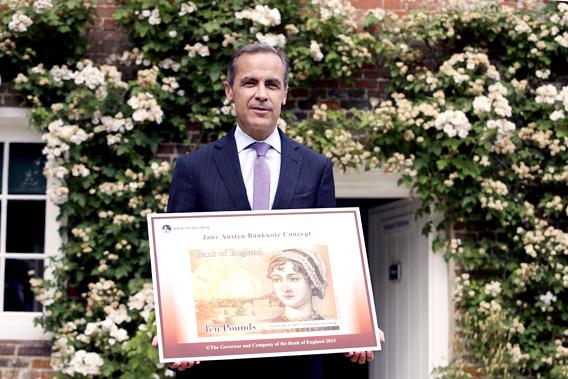The absurd and suddenly ugly controversy that has sprung up around the Jane Austen bank note tells us more about the Internet and current cultural habits than the poor author herself. After the Bank of England settled on Austen to replace Darwin as the face of the 10-pound note a couple of weeks ago, swirling critiques, angry blog posts, and bomb threats have unsettled the summer calm.
Apparently, in choosing faces for bank notes, the criteria are someone who has made an important and lasting contribution; is a household name; and is not controversial. One would imagine that of all the great writers England has produced, Jane Austen would perfectly fulfill these expectations. As far back as 1905, Henry James complained about “The body of publishers, editors, illustrators, producers of magazines, which have found their dear, our dear, everybody’s dear Jane so infinitely to their material purpose.”
On the face of it, “everybody’s dear Jane” would seem like one of the least controversial choices for bank note prominence: She is beloved by generations, popular yet highbrow, subversive yet mainstream, witty yet accessible; a smart, safely feminist choice, yet in certain lights, an upholder of traditional values. Is there, one could ask, a single woman writer less controversial than Jane Austen? But still, with our current passion for controversy a vivid controversy manages to brew around her.
No sooner was Darwin’s demise on the 10-pound note announced then anger flared up from every angle. There were attacks on her for being “a bitchy marriage broker who never married,” and “the sneering chronicler of petty squabbles and small lives.” There were attacks on her for being white: “It seems odd that in, 2013, all the faces on our banknotes are white.” There were attacks on her appearance, “her great gloopy eyes,” her “mean mouth,” (one of her own biographers once attacked her for looking like a “peevish hamster”) and for her being too obsessed with money (a particularly strange and arcane attack given that this is a conversation about a bank note). There were attacks on the quote accompanying the drawing, “I declare after all there is no enjoyment like reading,” which was meant disingenuously from the character in the book from which it was plucked. There were attacks on the Bank of England for “conspicuously playing it safe” arguing that Virginia Woolf, or Mary Wollstonecraft, or Mary Shelley would have been “more appropriate.” As if there were something “inappropriate” about Austen. The left, the right, the middle, the highbrow, the tabloidy, and the bloggy all found something to take issue with and object to.
The appalling threats on Twitter aimed at the activist and journalist, Caroline Criado-Perez, who lobbied originally for a woman on a bank note, and the Labour party member, Stella Creasy, who supported the campaign are another example of a reaction that has nothing at all to do with the specific issue at hand. (These threats included lines like “I’m going to pistol whip you over and over until you lose consciousness then burn ur flesh” and “ I will rape you tomorrow at 9pm” and “a bomb was placed in front of your house.”) The 21-year-old and 25-year-old men who have been arrested for these threats on Twitter can’t really have been staunch Charles Darwin defenders or violent Jane Austen haters; they must have been responding more to the idea of a woman saying anything. The minor and banal nature of the bank note controversy is our latest sign that anything at all can trigger the terrifying, free-floating rage adrift on the Internet. If Jane Austen makes people mad, one has to wonder, what doesn’t make people mad?
It doesn’t matter what happens, or what changes, or whose face replaces whose—we are angry about it anyway; we are chock full of clever and not so clever criticism; we can’t wait to take them apart whoever they are, and whatever it is. And the violent rage against a female writer or politician who says, well, anything, is there to be tapped into at any point. The bomb threat and rape threat are there, ready to happen, with or without the bonneted face of a nineteenth century woman.
It is ironic that Austen, the elegant, precise satirist that she was, should provoke this crude and unsophisticated and wild meanness. She was no stranger to anger, to simmering resentments and harsh judgments, to taking people down a notch, but her sentences were if anything the opposite of “a bomb was placed in front of your house.”
